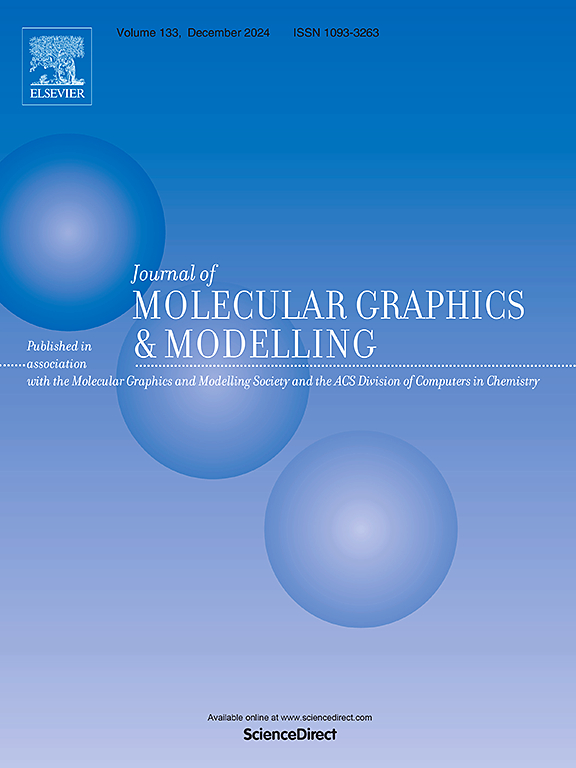基于结构的虚拟筛选和多变量分析,组合化学驱动的共价拟肽SARS-CoV-2主要蛋白酶抑制剂的计算机设计和计算评估
IF 3
4区 生物学
Q2 BIOCHEMICAL RESEARCH METHODS
引用次数: 0
摘要
COVID-19大流行凸显了在现有疫苗之外迫切需要特定的药物治疗。抗病毒疗法开发中最具吸引力的靶点之一是SARS-CoV-2主蛋白酶(MPRO),这是病毒生命中的关键酶。MPRO人类同源物的缺乏及其在冠状病毒中的保存率使得该酶具有重要的战略意义。考虑到其作用机制,催化半胱氨酸残基(Cys145)是共价抑制的主要靶点。亲电战斗部抑制剂设计用于与该催化位点反应,模拟病毒多蛋白的酰胺肽键,从而促进它们的结合和随后的酶失活。当它们被纳入拟肽结构时,活性进一步增强。在寻找有效的COVID-19治疗方法中,计算机方法越来越重要。因此,本研究的重点是开发一种创新的芯片方案,用于鉴定共价靶向MPRO的抗sars - cov -2药物。为此,通过对接研究,生成了450个具有醛类战斗部的拟肽化合物组合文库,并将其精炼为388个化合物,并进一步评估了共价结合能力,结果表明,即使在200 ns动力学模拟中,化合物9-14、16和20也比已知抑制剂具有更高的亲和力,从而肯定了所采用设计策略的有效性。此外,这项工作利用了我们内部基于配体的工具,生物靶预测工具,可在DRUDIT中使用,结合了基于结构的技术和有趣的多元统计分析。本文章由计算机程序翻译,如有差异,请以英文原文为准。

Combinatorial chemistry-driven In silico design and computational evaluation of covalent peptidomimetic SARS-CoV-2 main protease inhibitors via structure-based virtual screening and multivariate analysis
The COVID-19 pandemic has underscored the urgent need for specific pharmacological treatments beyond existing vaccines. One of the most attractive targets for antiviral therapies development is the SARS-CoV-2 Main Protease (MPRO), a key enzyme in viral life. The lack of MPRO human homologs and its conservation rate among coronaviruses make this enzyme strategically important. Considering its mechanism of action, the catalytic cysteine residue (Cys145) presents a prime target for covalent inhibition. Electrophilic warhead inhibitors, designed to react with this catalytic site, mimic the amide peptide bonds of the viral polyproteins, thereby facilitating their binding and subsequent inactivation of the enzyme. Their activity is further potentiated when incorporated into peptidomimetic structures. In silico approaches are gaining increasing importance in the search for effective COVID-19 treatments. In this view, this study focuses on developing an innovative in silico protocol for identifying anti-SARS-CoV-2 agents covalently targeting MPRO. To this purpose, a combinatorial library of 450 peptidomimetic compounds with aldehydic warheads was generated, refined to 388 compounds through docking studies, and further evaluated for covalent binding capabilities, revealing that compounds 9–14, 16, and 20 exhibited significantly higher affinities compared to known inhibitors, even during a 200 ns dynamics simulation, thus affirming the validity of the adopted design strategy. Furthermore, this work takes the advantages of our in-house ligand-based tool, the Biotarget Predictor Tool, available in DRUDIT, integrated with both structure-based techniques and, interestingly, multivariate statistical analysis.
求助全文
通过发布文献求助,成功后即可免费获取论文全文。
去求助
来源期刊

Journal of molecular graphics & modelling
生物-计算机:跨学科应用
CiteScore
5.50
自引率
6.90%
发文量
216
审稿时长
35 days
期刊介绍:
The Journal of Molecular Graphics and Modelling is devoted to the publication of papers on the uses of computers in theoretical investigations of molecular structure, function, interaction, and design. The scope of the journal includes all aspects of molecular modeling and computational chemistry, including, for instance, the study of molecular shape and properties, molecular simulations, protein and polymer engineering, drug design, materials design, structure-activity and structure-property relationships, database mining, and compound library design.
As a primary research journal, JMGM seeks to bring new knowledge to the attention of our readers. As such, submissions to the journal need to not only report results, but must draw conclusions and explore implications of the work presented. Authors are strongly encouraged to bear this in mind when preparing manuscripts. Routine applications of standard modelling approaches, providing only very limited new scientific insight, will not meet our criteria for publication. Reproducibility of reported calculations is an important issue. Wherever possible, we urge authors to enhance their papers with Supplementary Data, for example, in QSAR studies machine-readable versions of molecular datasets or in the development of new force-field parameters versions of the topology and force field parameter files. Routine applications of existing methods that do not lead to genuinely new insight will not be considered.
 求助内容:
求助内容: 应助结果提醒方式:
应助结果提醒方式:


